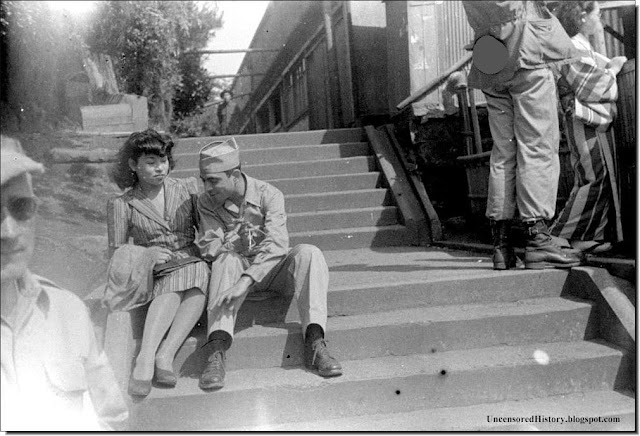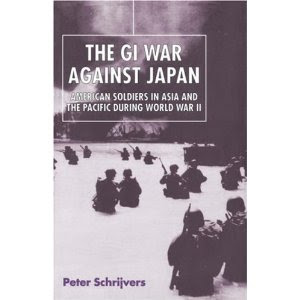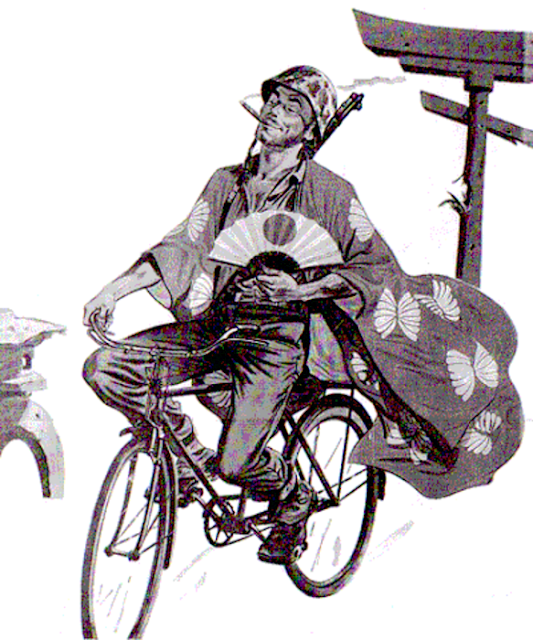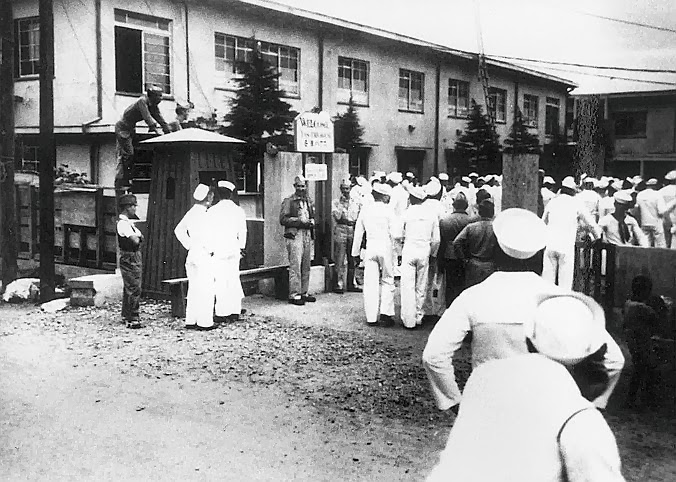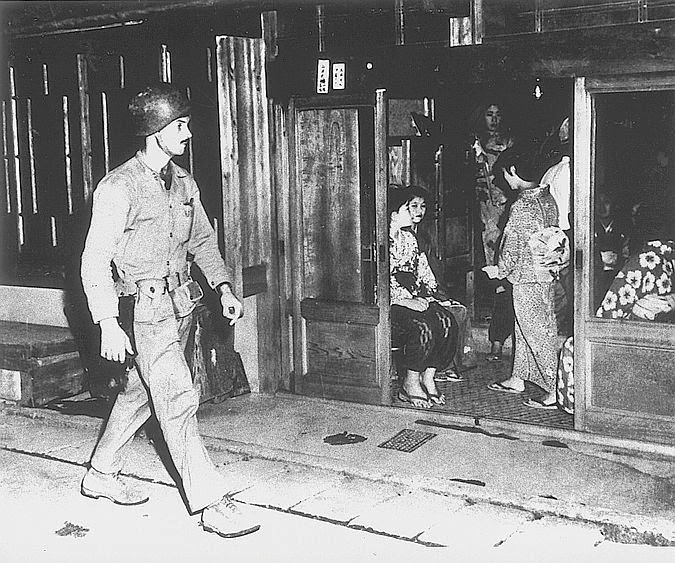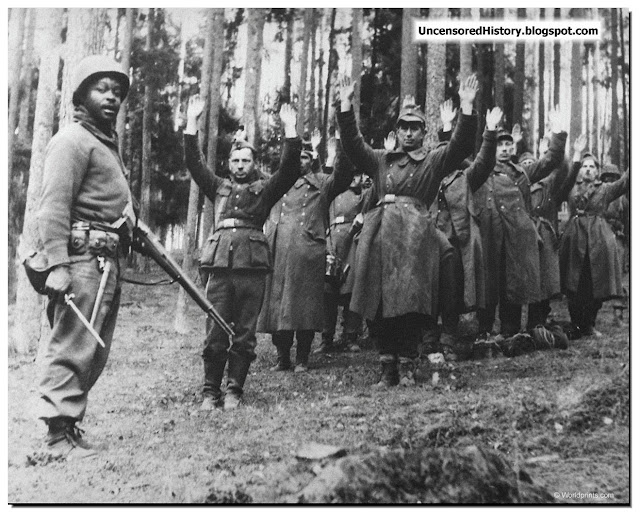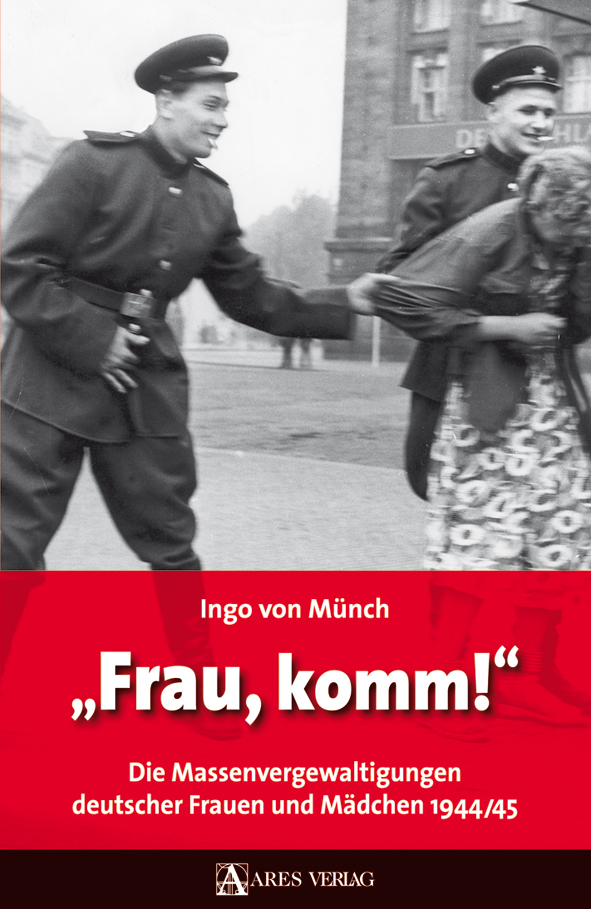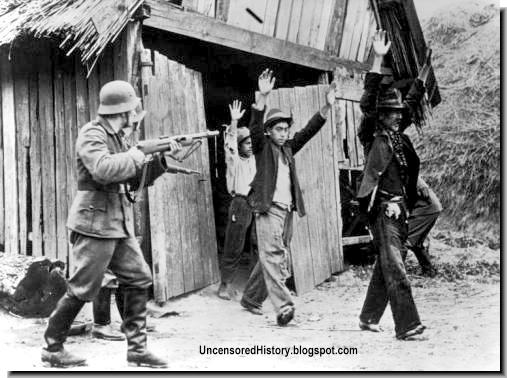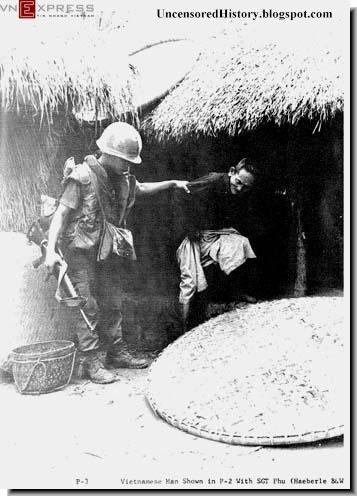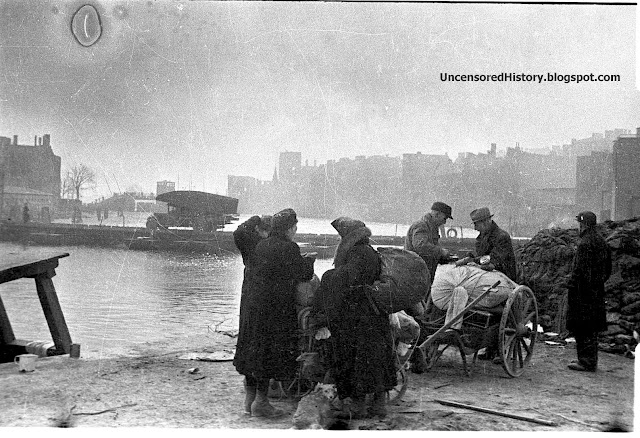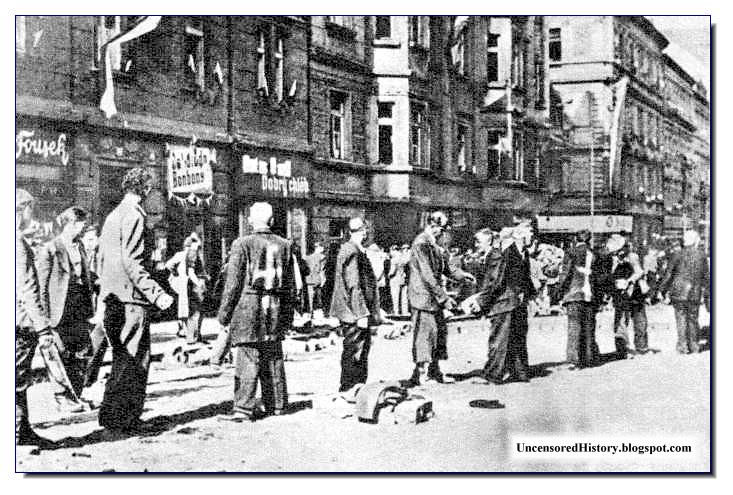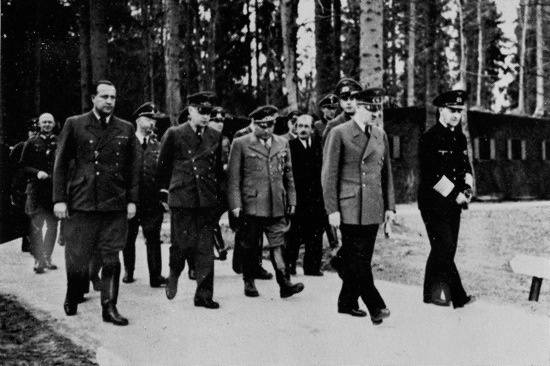“We too are an army of rapists,”
anonymous soldier, letter to the editor, Time Magazine, November 12, 1945.
In Hollywood movies we have seen the bad man from the SS raping (or attempting to) a beautiful lady (French, British or American). Lately we are increasingly learning of the mass rape of German women by the Red Army hordes in 1945. We have heard of the bad black French colonial troops raping German women in Stuttgart in 1945. Now a lesser reported event of the brutal WW2..... Rape of Japanese women by GIs during the end of the war and during the occupation of Japan......
Japanese historian Oshiro Masayasu writes about the large scale rape by American soldiers in Okinawa in 1945. He reports the incident at a village in Motobu peninsula where GIs landed and found only women, children and old folks there. What followed was abominable. There was a hunt in broad daylight for Japanese women who were ravaged mercilessly.
There is no documentary evidence that mass rape was committed by Allied troops during the Pacific War. There are, however, numerous credible testimony accounts which allege that a large number of rapes were committed by US forces during the Battle of Okinawa in 1945.
Okinawan historian Oshiro Masayasu (former director of the Okinawa Prefectural Historical Archives) writes based on several years of research:
Soon after the U.S. marines landed, all the women of a village on Motobu Peninsula fell into the hands of American soldiers. At the time, there were only women, children and old people in the village, as all the young men had been mobilized for the war. Soon after landing, the marines "mopped up" the entire village, but found no signs of Japanese forces. Taking advantage of the situation, they started "hunting for women" in broad daylight and those who were hiding in the village or nearby air raid shelters were dragged out one after another.
According to Toshiyuki Tanaka, 76 cases of rape or rape-murder were reported during the first five years of the American occupation of Okinawa. However, this is probably not the true figure, as most cases went unreported.
In 1998 the remains of three U.S. Marines stationed on Okinawa were discovered outside of a local village. Accounts from elderly Okinawans claim that the 3 marines had made frequent trips to the village to rape the women that lived there, but were ambushed and killed by dozens of villagers with the help of 2 armed Japanese soldiers who were hiding in the jungle, in a dark narrow mountain pass near a river on one of their return trips. "The Japanese soldiers shot at the marines from the bushes and several dozen villagers beat them to death with sticks and stones." According to the same article, one academic claims that "rape was so prevalent that most Okinawans over age 65 either know or have heard of a woman who was raped in the aftermath of the war."
Source;
Yuki Tanaka/Toshiyuki Tanaka, Japan's Comfort Women: Sexual Slavery and Prostitution During World War II, p. 110-111.
The rape of Okinawan women by American soldiers continued even after the war officially ended and there are many incidents in which American soldiers took young girls from civilian houses at gunpoint. These girls would later return with their clothes torn off. Some were even killed, although the perpetrators were never caught. As a result, villagers throughout Okinawa used a warning signal of banging on pots and pans to warn of approaching American troops. On hearing this, girls would hide until all was clear. Some women were also raped when they went to US camps to receive food hand-outs. During the first five years of the American occupation of Okinawa, 76 cases of murder or rape-murder were reported. This number was but the tip of the iceberg, as most cases went unreported.
Tanaka Page 133
1 Around 12:30 am on September 1, three American soldiers intruded in to
the house of Mr. B. I., [the details of the address], Awa district in Chiba
prefecture. These intruders showed something like a ten yen bank note to
the housewife N., 28 years old and claimed intimacy to her by making
gestures while upon receiving her flat refusal they brought her to the inner
room and raped her in succession.
2 At about 2:00 pm the same day another four American soldiers intruded
into the house of Mr. A. T., [the details of the address], the same village.
They threatened the wife, T. aged 30 as well as his mother and then chased
the three to the next room and one of the Americans violated T. in the first
place. But at that time another three American soldiers entered the
same house. They withdrew from the house without attaining their intended
purposes satisfactorily.
3 At the same hour on that day seven American soldiers while ransacking the
village office in Nishiki village, resorted to indecent acts such as touching
breasts of the girl clerks or rubbing their cheeks.
4 Another several Americans resorted to the same acts to the girl clerks in the
post office located in the same village
in a truck forced two Japanese to guide them around the Yokohama city.
When they came to Shojikiro, at Eirakucho, Naka-ku they forced Miss
K. Y., aged 24, a maidservant, to board the truck against her will and
absconded to the US Barracks in Nogeyama Park. There altogether 27 of
the American soldiers violated her in turn and rendered her unconscious,
though she later recovered her consciousness through the care of some other
American soldiers and was sent home on September 2nd.
Source;
Schrijvers, Peter (2002). The GI War Against Japan. New York City: New York University Press. p. 212. ISBN 0814798160.
For instance, rape--which is considered a way to sharpen aggressiveness of soldiers, steeling male bonding among warriors, and, moreover, "reflects a burning need to establish total dominance of the other" (p. 211)--was a general practice against Japanese women. "The estimate of one Okinawan historian for the entire three-month period of the campaign exceeds 10,000. A figure that does not seem unlikely when one realizes that during the first 10 days of the occupation of Japan there were 1,336 reported cases of rape of Japanese women by American soldiers in Kanagawa prefecture alone" (p. 212).
Immediately after the Japanese surrendered in 1945, the Japanese Ministry of the Interior made plans to protect Japanese women in its middle and upper classes from American troops. Fear of an American army out of control led them to quickly establish the first “comfort women” stations for use by US troops. By the end of 1945, the Japanese Ministry of Home Affairs had organized the Recreation Amusement Association (R.A.A.), a chain of houses of prostitution with 20,000 women who serviced occupation forces throughout Japan. (Many more women known as panpan turned to prostitution in the struggle to survive in the midst of the postwar devastation.) Burritt Sabin of the Japan Times reported in 2002 that just days before the R.A.A. was to open, hundreds of American soldiers broke into two of their facilities and raped all the women. The situation prompted MacArthur and Eichelberger, the two top military men of the U.S. occupation forces, to make “rape by Marines” their very first topic of discussion. Yuki Tanaka notes that 1300 rapes were reported in Kanagawa prefecture alone between August 30 and September 10, 1945, indicative of the pervasiveness of the phenomenon in the early occupation.
Historian Takemae Eiji reports that
. . . US troops comported themselves like conquerors, especially in the early weeks and months of occupation. Misbehavior ranged from black-marketeering, petty theft, reckless driving and disorderly conduct to vandalism, assault arson, murder and rape. . . . In Yokohama, Chiba and elsewhere, soldiers and sailors broke the law with impunity, and incidents of robbery, rape and occasionally murder were widely reported in the press.
Two weeks into the occupation, the Japanese press began to report on rapes and looting. MacArthur responded by promptly censoring all media. Monica Braw, whose research revealed that even mention of the atomic bombing of Hiroshima and Nagasaki, and particularly the effects of the bomb on civilians, were censored, maintains that pervasive censorship continued throughout the occupation years. "It [censorship] covered all means of communications and set up rules that were so general as to cover everything. It did not specify subjects prohibited, did not state punishment for violations, although it was clear that there were such punishments, and prohibited all discussion even about the existence of the censorship itself."
Censorship was not limited to the Japanese press. MacArthur threw prominent American journalists such as Gordon Walker, editor of the Christian Science Monitor, and Frank Hawley of the New York Times out of Japan for disobeying his orders. Even internal military reports were censored.
Five months after the occupation began, one in four American soldiers had contracted VD. The supply of penicillin back in the U.S. was low. When MacArthur responded by making both prostitution and fraternization illegal, the number of reported rapes soared, showing that prostitution and the easy availability of women had suppressed incidents of rape.
John Dower writes in his Embracing Defeat: Japan in the Wake of World War II that while the U.S./Japanese-sponsored brothels were open “the number of rapes and assaults on Japanese women were around 40 a day,” but after they were closed, the number rose to 330 a day.
Yuki Tanaka records two major incidents of mass rape around the same time. On April 4, fifty GIs broke into a hospital in Omori and raped 77 women, one a woman who had just given birth, killing the two-day-old baby by tossing it onto the floor. On April 11, forty U.S. soldiers cut off the phone lines of one of Nagoya’s city blocks and entered a number of houses simultaneously, “raping many girls and woman between the ages of 10 and 55 years.”
If these incidents are in any sense indicative, how are we to understand the fact that reports in U.S. archives about rape in postwar Japan are sparse: General Eichelberger issued three documents during the first year of the Japanese occupation admonishing the troops about their behavior, citing looting, rape and robbery. General Eisenhower ordered a report about troop behavior on Japan and the Philippines in 1946. (The National Archives has the report’s cover sheet, but not the report.) Albert Hussey, one of the framers of the Japanese constitution, mentions the rise of “institutional rape.” Under the cover of screening for venereal diseases, young women getting home from work were arrested in the subway or in the streets, pressed to have relations and/or examined by Japanese doctors in the presence of soldiers. Rape continued during the occupation as indicated by the plea reported in the NY Times April 21, 1952, from a prominent woman leader, Ms. T. Uyemura, to Mrs. Ridgway, wife of MacArthur's replacement, General Ridgway, asking her husband to isolate the immoral US troops.
Recorded courts-martial for rape during the occupation are few. The Judge Advocate General’s Board of Review for the year 1946, when the R.A.A. closed, shows only 6 courts-martial. The Return of General Prisoners from the 8th Army stockade in Tokyo, where all GI prisoners were incarcerated prior to being returned to the U.S., lists 6 soldiers sentenced for rape during spring 1946.26 The Index to the Board of Review Opinions of the Branch Office of the JAG (1942-1949) shows only two courts-martial listed during the same period.
French researcher Bertrand Roehner has made available the texts of hundreds of directives from the Supreme Commander of the Allied Powers to the Japanese government (called SCAPs, SCAPINS or SCAPINs) that reveal much more sexual violence occurred than has ever been acknowledged, a small window onto what went on behind MacArthur’s wall of censorship.
For example, the SCAPIN of August 31, 1949 is illustrative of another tactic MacArthur used to suppress reports of rape and other crimes by occupying forces. It shows that five Japanese were sentenced to hard labor “for spreading rumors derogatory to occupation forces” when American soldiers were accused of raping Japanese women. Another instance of this policy is noted by Takamae Eiji:
When US paratroopers landed in Sapporo, an orgy of looting, sexual violence and drunken brawling ensued. Gang rapes and other sexual atrocities were not infrequent. Victims of such attacks, shunned as outcasts, sometimes turned in desperation to prostitution; others took their life rather than bring shame to their families. Military courts arrested relatively few soldiers for these offenses and convicted even fewer, and restitution for the victims were rare. Japanese attempts at self-defense were punished severely. In the sole instance of self-help that General Eichelberger records in his memoirs, when local residents formed a vigilante group and retaliated against off-duty GIs, Eighth Army ordered armoured vehicles in battle array into the streets and arrested the ringleaders, who received lengthy prison terms.
My uncle, Don Svoboda, unwittingly introduced me to this subject. He committed suicide in 2004, leaving behind audiotapes that spoke of the building of a gallows in Tokyo’s 8th Army stockade where he served as an M.P. in 1946. In trying to discover whether an execution he had witnessed decades earlier had anything to do with his suicide, I interviewed many veterans who had served in the stockade. Five of them remembered “a colored boy” being executed for rape in May; none of them remembered his name; two thought there was more than one execution. No records from the 8th Army stockade report any executions, and neither Truman nor MacArthur signed any military execution papers during 1946, the year that the soldiers remember the hanging. In addition, no records speak of the use, or even the building of the very large gallows that all the vets remembered, including soldiers who were just passing through on their way to Korea in 1952, just before it was dismantled.
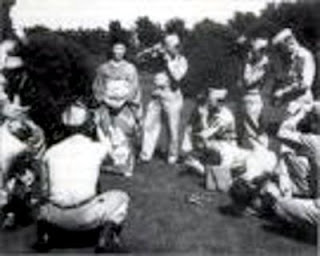 |
| AMERICAN SOLDIERS PHOTOGRAPH JAPANESE WOMEN IN OCCUPIED JAPAN |
J. Robert Lilly, who has written extensively on executions of black soldiers during WWII, discovered that questioning the families of dead soldiers did not necessarily determine whether a soldier had been executed because sometimes the military reported deaths due to other causes. In trying to trace the executed men, I found that pursuing the records of soldiers who died in occupied Japan was also fruitless. No soldiers were buried in Japan, and those executed are not distinguished from those who died accidentally or from natural causes. In addition, many of the 202 Americans cremated in Japan are among those listed as unknown. An examination of chaplains’ and physicians’ records regarding executions also reveals no relevant material. Emailing and writing to the historian at the 8th Army Public Affairs office in Yongsan, Korea was met with silence. Files around the subject of executions during the occupation consulted at the National Archives sometimes contain lists of the contents but no contents, a situation confirmed by Roehner’s experiences at the Archives in the US and in Japan.
Although Roehner maintains that a kind of “omerta” surrounds occupation records worldwide, there are other possible explanations for some of the omissions. The 1973 National Archives fire offers one possible explanation for the lack of documentation regarding soldiers’ records--at least it is most often cited. The Bush Administration’s funding cuts to the National Archives make it very difficult for archivists to process or even become familiar with the huge holdings. Many of the occupation files in the National Archives are filed either with WWII or Korean War papers—but sometimes at the beginning of administrative files marked 1950, which makes them difficult to locate.
According to my uncle, most of the serious offenders in the 8th Army stockade were black. Alice Kaplan writes in The Interpreter, a book that discusses the discrepancies in sentencing between black and white servicemen convicted of rape in the European theater, that black troops who made up 8.5 percent of the armed forces during WWII were accused of committing 79 percent of all capital crimes. Lilly reports that while 57% of the soldiers accused of sexual offenses in Europe were white, most of the convicted were black, some 66%. “It is quite possible that the complaints against black soldiers were those the army selected to record, thus indirectly creating an incomplete and inaccurate account,” he writes. They were also more likely to be tried because of commander prejudice, many commanders being Southerners. Although white and black soldiers were convicted of rape in both theaters during the war, only black servicemen were executed for this crime. Racial prejudice at a time when lynching was frequent in civilian life in the south and the military remained segregated is censorship’s “elephant in the room.”
The US government, with Japanese collaboration, has suppressed important information about crime and punishment during the occupation: it has concealed the numbers of rapes and the identity of the perpetrators; it has concealed the prosecutions, arrests and executions for rape and other crimes. There is reason to believe that the information is not only politically charged in terms of the US-Japan relationship, but that it is racially charged. Specifically, the extreme punishment of blacks charged with rape—in several cases including execution—is a reminder of the Jim Crow justice of an earlier era.
This is a revised and expanded version of a paper presented at The American Society for Legal History, Ottawa, November 2008.
COMFORT WOMEN FOR AMERICAN SOLDIERS IN JAPAN
1 It is still beyond speculation where the foreign troops will be stationed
and when they will arrive. Therefore, do not cause public unrest by
forming a hasty conclusion that it is inevitable for those troops to advance
to your prefecture.
2 Make preparation of such facilities now confidentially as their prompt
establishment is required in the case of the troops’ station, but ensure
that the information not be revealed to the outside.
3 In carrying out this plan, avoid arousing misunderstanding among local
people by explaining to them that this scheme will be implemented for
the purpose of protecting Japanese citizens.
The outline of the preparation for the establishment of comfort facilities for the foreign troops:
1 Allow the business for the foreign troops within limited quarters, regardless
of existing regulations of control.
2 The above-mentioned limited quarters should be determined by the
[prefectural] police chief, and prohibit Japanese subjects from using the
facilities.
3 The police chief should actively give guidance in management of the
following facilities and promote their rapid expansion.
• Sexual comfort facilities
• Eating and drinking facilities
• Recreation centres
4 Recruit the women required for the business from geisha, licensed and
unlicensed prostitutes, waitresses, barmaids, habitual illicit prostitutes
and the like.
Japan's Comfort Women: Sexual Slavery and Prostitution during World War II and the US Occupation By Toshiyuki Tanaka
RAPE BY JAPANESE SOLDIERS (AND LATER OCCUPYING AMERICAN SOLDIERS)
Japan's Comfort Women tells the harrowing story of the "comfort women" who were forced to enter prostitution to serve the Japanese Imperial army, often living in appalling conditions of sexual slavery. Using a wide range of primary sources, the author for the first time links military controlled prostitution with enforced prostitution. He uncovers new and controversial information about the role of the US' occupation forces in military controlled prostitution, as well as the subsequent "cover-up" of the existence of such a policy. This groundbreaking book asks why US occupation forces did little to help the women, and argues that military authorities organised prostitution to prevent the widespread incidence of GI rape of Japanese women, and to control the spread of sexually transmitted diseases.
-------------------------------------------------------------
RELATED
Rape Of French Women By American Soldiers During WW2
Rape of German Women During WW2 (Eyewitness Account)
Rape of German Women When The Country Lost The War
Mass rape of German Women
Rape By German And Waffen SS
Rape And Abuse Of Asian Women By Japanese Soldiers During WW2
